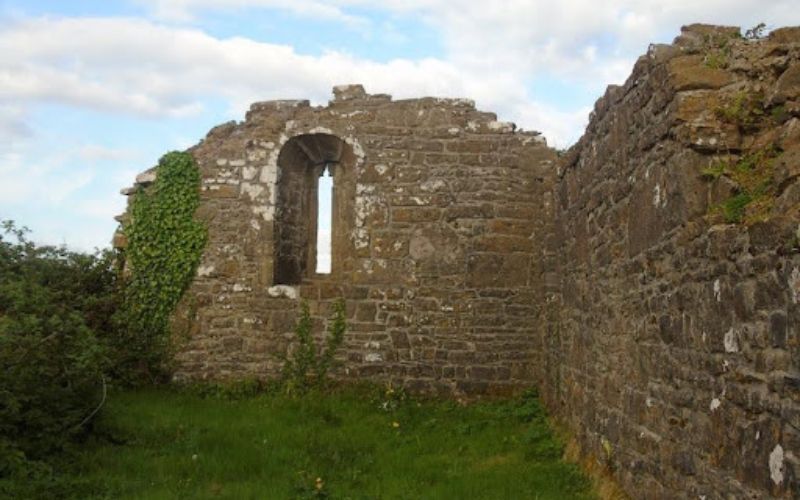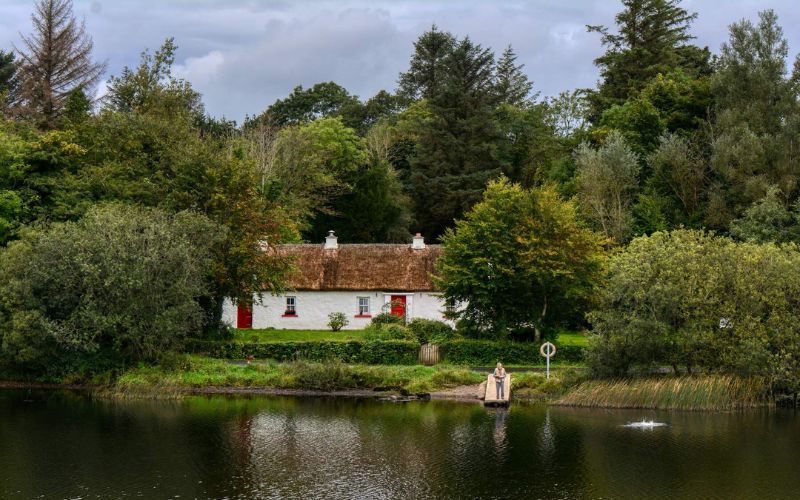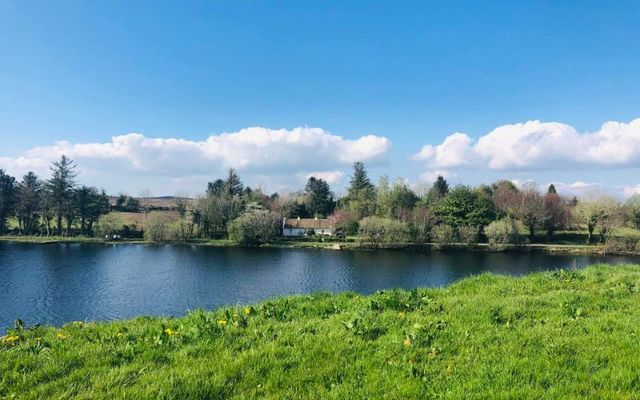Every Irish family has a personal story that they are told as children about how their family is connected to an important place in Irish history.
I will tell one of my family’s stories that was told to me when I was a young lad, standing by the ancient historical shore of Keenaghan Lough right by Keenaghan Abbey—a spiritual place of peace—bearing history to my family’s name.
Although this is my family’s story, it will also resonate with other Irish families because, as James Joyce reminds us, “in the particular is contained the universal."
Keenaghan Lough and Keenaghan Abbey in Co Fermanagh are symbolic touchstones for this story of generational memory, this story of a family of faith, this story of protecting Irish history and preserving Irish identity. Maybe in telling this story and sharing it with a transatlantic Irish audience throughout the world, it can play a part in helping to protect and preserve Keenaghan Lough and Keenaghan Abbey.
These natural and historic monuments are currently under attack from the proposed development of a glamping pod site with large amenity buildings, and a car park for almost 100 vehicles that will destroy the natural environment and desecrate the historic landscape.

My story begins with my great, great grandad James ‘Black’ Keenaghan, the grandson and son of two other Jameses. His grandad appears on the Flax Growers List, 1796 who grew half an acre of flax earning himself two spinning wheels. His dad appears in the Tithe Applotment Books, 1834, and was a farmer and well-known weaver.
Sometime around Halloween in 1873, Black James coolly rode his horse and cart from his home in Rathmore, Ballyshannon, Co Donegal to Rathmore, Belleek, Co Fermanagh—from one great rath to another. His nickname ‘Black’ James is a bit of a mystery. Maybe it was borne out of the fact that he was born in 1847, the blackest year of the Irish Famine when a million Irish people died, and a million Irish people were forced to emigrate. Maybe it was colored by his jet-black hair, which was so striking you could not see his sable strands on a dark night, or maybe it was his childlike love of riding wild black horses bareback around Rathmore.
As Black James’ two black horses and gold cart wheels were spinning and weaving through Cloghore, the place of the gold stone, he was nearing Belleek’s old bridge, but he was not alone. He was riding along with his newly married wife Jane Mc Cauley, the daughter of Daniel Mc Cauley, a farmer and shoemaker, and she was cradling their first-born daughter, Mary. Jane had worked as a housemaid in the Rock of Bundoran, while James had worked as a farm servant herding cattle in Maghercar, Bundoran. Black James was a loveable rogue and a pure rebel heart—an Irish cowboy.
It was during one lively St. Patrick’s Day by the bridge over the Bradóge River in Bundoran when James and Jane first met, and they courted around the long strand of Rougey in high passion. Belleek offered a new life and opportunity for this young family to settle down and make it their home.
James already had family in Belleek. His uncle Edward lived on Main Street during the Griffith’s Valuation, 1862 through the 1870s. Edward was a laborer and stone mason and sometime during the 1830s-1850s, he was one of the construction laborers involved in building Maghermenagh Castle and Belleek Pottery. James’ sister Catherine was a flowerer artisan in the pottery, too.
Many of James and Jane's sons and daughters, including my own great grandad, Jack, would later work in the pottery as recorded in the Census of Ireland 1901/1911 up until Jack’s brother, Eddie ‘Cute’, retired from there in the 1950s.
Stories of Eddie ‘Cute’ were told to me by Belleek historian, Joe O’Loughlin, who was his neighbor in the Commons, Belleek. ‘Cute’, like his father, was a “loveable Irish rogue- of good sound character.”
Joe, as well as Joe Magee, from the Mulleek Community Association, were key figures in the initial conservation of Keenaghan Abbey in 2010 on Hidden Heritage.
The year before James and Jane arrived in Belleek in 1872, it was a significant year for Ireland’s oldest craft pottery, the world-famous Belleek Pottery. They had just showcased their Parian ware for the first time at the Dublin Exposition of 1872. One of the featured pieces was a figure entitled “Hibernia Awakening from her Slumber."
As James slowed his horse reins, venturing over the threshold of the old bridge, his baby daughter, Mary, awakened from her slumber, too— opening her infant eyes like a porcelain Hibernia herself—gazing at the sunlight illuminating the architectural marvel of Belleek Pottery.
James and Jane blessed themselves crossing the old bridge over the majestic River Erne entering Belleek—the streaming falls from Rose Isle inspired their new life. James invoked the town’s namesake, Béal Leice, the ford-mouth of the flagstones. He rode through the heart of the town, nodding to the villagers, but picked up the pace riding out the Boa Island road. The destination for ‘Black’ James Keenaghan was Keenaghan—peacefully shining in the distance—Keenaghan Lough and Keenaghan Abbey.
Many years later my grandad, Dan, my dad, John, and I made our pilgrimage to Keenaghan Lough and Keenaghan Abbey. We had just attended the mart in Belleek and spoken to my great uncle on my mother’s side, Belleek historian, Jim Flanagan. I was just a young lad as we travelled to Keenaghan, but we were following the spirit-steps of our ancestors. While my dad was studying the masonry of the eastern gable window, shaped like a stone sculpted candle, I saw my grandad by the lough kneeling and praying. He was blessing himself with the lough water that was lapping in the Yeatsian way “with low sounds by the shore” and there was the slight wisp of turf smoke permeating like incense from Keenaghan Cottage across the tranquil lough.
Grandad made the sign of the cross on my wondering forehead. I blessed myself, “In the name of the Father, and of the Son,” and after I said, “Holy Spirit” my grandad revealed to me how his grandad, ‘Black’ James, travelled here for the very first time to Keenaghan Lough and Keenaghan Abbey to baptize his first-born, Mary. James would baptize all his nine children in the lough: Mary, James Jr., Celia, Eddie ‘Cute’, Annie, twins Daniel and Terence, Bridget, and my grandad’s father, Jack. The tradition continued with Jack baptizing my grandad here in 1926, who was the last Belleek Keenaghan to be baptized in Keenaghan Lough.
Lough baptisms have deep roots in ancient Irish tradition, a tradition the old monks at Keenaghan Abbey would have known well when they baptized their faithful in the lough. Keenaghan Lough is not just a peaceful lough, it is a baptismal font. Keenaghan Abbey is not just a historic abbey, it is an altar, and the fields around Keenaghan are not just green fields they are the sacred shrine that surrounds this unique part of Irish history.
Every time I reflect upon Keenaghan while living here in the US, I reimagine one word of Yeats’ poem “The Lake Isle of Innisfree”: “I will arise and go now, and go to Keenaghan . . . And I shall have some peace there, for peace comes dropping slow, Dropping from the veils of the morning to where the cricket sings; There midnight’s all a glimmer, and noon a purple glow, And evening full of linnet’s wings. I will arise and go now, for always night and day I hear lake water lapping with low sounds by the shore; While I stand on the roadway, or on the pavements grey, I hear it in the deep heart’s core.”
My family’s story is only one part of one chapter of the story of Keenaghan Lough and Keenaghan Abbey. There are many more stories from the good people of Belleek who are now fighting to protect and preserve their heritage.
Apart from the medieval abbey established by early Irish saints, Keenaghan has an ancient history. A Janus Head figure and crannog dating back to antiquity were also found here. It survived the Viking raids in the 9th century, as well as the Cromwellian Invasion in the 17th century.
The question remains will it survive through the 21st century? Ultimately, it is up to every Irish person to take a united stand to protect Irish history, because when we do, we preserve our Irish identity for many generations to come.
If readers of IrishCentral would like to play a part in protecting and preserving Keenaghan Lough and Keenaghan Abbey, then please first sign the petition. A glamping site will have a “Significant Adverse Impact” as stated by the Historical Environment Division (HED). The petition was created by Lisa McWilliams, who, along with her family, has wonderfully renovated and preserved Keenaghan Cottage, which is Ireland’s only 5 Star Authentic Irish Thatched Cottage Accommodation.

Keenaghan Cottage overlooking Lough Keenaghan, Belleek, Co. Fermanagh. (Ireland's Content Pool)
If you wish to further support the cause, please follow Belleek Historical Society led by Stephen Heron who recently told his story about Keenaghan Lough and Keenaghan Abbey on Ocean FM.
Lisa and Stephen are ambassadors for Belleek. They greatly support tourism and development, but they believe that “it needs to be the right development in the right place” and “not at the expense of so much more important factors such as Heritage, Conservation, Road Safety, Wildlife, Environmental issues and so on.”
I hope and pray that by sharing my story and highlighting the efforts of the McWilliams family at Keenaghan Cottage and Stephen Heron at Belleek Historical Society it can play a part in protecting and preserving Keenaghan Lough and Keenaghan Abbey.
Maybe someday I can tell the same story that my grandad, Dan, told me about his grandad, ‘Black’ James, to my own grandchildren, standing by the ancient historical shore of Keenaghan Lough right by Keenaghan Abbey—a spiritual place of peace—bearing history to not only my family’s name, but to all families within Irish history.
*Eamon O'Caoineachan, originally from Co Donegal, received his Masters in Irish Studies at the University of St. Thomas in Houston and now works as a freelance writer and poet.




Comments